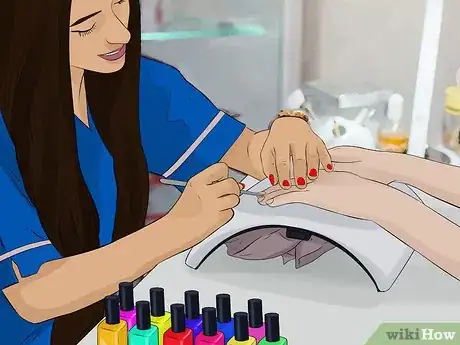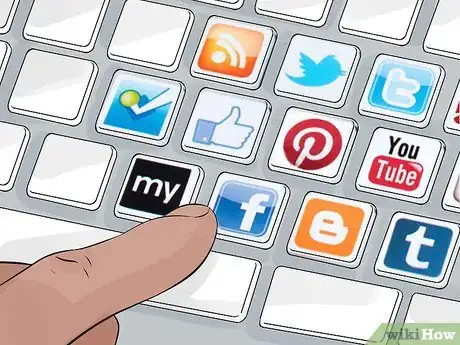This article was co-authored by Mia Rubie. Mia Rubie is a Nail Artist and the Owner of Sparkle San Francisco, a nail studio based in San Francisco, California. She has over eight years of nail artist and management experience and is known for her push-the-envelope designs and artistic eye for colors. Her clients include Sephora, Target, and Vogue. Her work has been featured in the San Francisco Chronicle and StyleCaster. She holds a BBA focusing on Entrepreneurial and Small Business Operations from San Francisco State University. You can find her work on her Instagram account @superflynails.
There are 18 references cited in this article, which can be found at the bottom of the page.
wikiHow marks an article as reader-approved once it receives enough positive feedback. This article received 15 testimonials and 89% of readers who voted found it helpful, earning it our reader-approved status.
This article has been viewed 482,025 times.
Because of their straightforward business model, salons are often easier to break into than other types of startups. This means you can spend more time doing nails and less time chewing your own. After you’ve applied for your operator’s license and found a suitable location, your chief concern will be getting your hands on all the equipment and supplies you’ll need to carry out business on a day-to-day basis. From there, it will just be a matter of managing your resources and polishing your image to leave your clients happy and looking fabulous.
Steps
Getting Your Business off the Ground
-
1Get some experience working in a salon. If you’ve only ever set foot in a nail salon as a customer, consider putting your dream on hold and getting a job at an established salon. Becoming a technician yourself will give you a better understanding of the unique skills and demands of the profession. In time, this expertise will play directly into your success as an entrepreneur in the field of beauty.[1]
- Even a part-time job can serve as a valuable learning experience while you’re gathering your resources.
- As you’re working your way up the ladder, pay close attention to the administrative side of the business. This is the role you’ll be stepping into once you become a full-fledged salon owner.[2]
-
2Decide what sort of salon you want to open. Begin by formulating a vision for your business. Do you imagine it as an urban oasis where tired clients can come to be pampered, or an in-and-out cash cow that caters to a hectic professional crowd? Once you have some idea of what you want to achieve, you’ll be better prepared to plan accordingly.[3]
- The goals you lay out for your salon may have an impact on your location, spatial requirements, or the number and type of services you provide.
Advertisement -
3Obtain all necessary licenses. Licensing criteria will differ depending on where you live, but at the very least you’ll need to be able to show proof of your cosmetology certification and apply for a standard operator’s license to conduct business. Additionally, some U.S. states require that salon owners carry a seller’s permit in order to be recognized as a legal vendor of specialty products.[4]
- If you haven't already, start researching cosmetology programs in your area. These courses typically take 1-2 years to complete. At the end of this time, you'll be awarded the credentials you need to operate your own salon.[5]
- You can file for your operator’s license, along with other licenses like different classes of seller’s permits, through the central business licensing association for your state or territory. For more information on licensing and local laws, contact your city’s business affairs board or visit your county clerk’s office.[6]
-
4Build up your capital. Start setting aside as much money as you can to finance your upcoming business venture. If necessary, you can apply for a business loan to supplement the money you’ve saved up. There's also the option of seeking contributions from your friends and loved ones.[7]
- Consider opening a savings account to keep your startup money separate from the rest of your finances.
- While you're in the planning stages of opening your nail salon, cut down on unnecessary spending as much as possible. Every cent you save will bring you closer to realizing your dream.[8]
-
5Estimate your total startup costs. Identify all the places your money will be going to get your salon off the ground. Along with the regular cost of operation once you’re up and running, there will be expenses associated with leasing, licensing and property inspection, taxes and basic equipment and supplies. There will also be the matter of payroll once you begin hiring employees to work under you.[9]
- Consult with a professional business adviser or talk to the owner of the salon you frequent to get an idea of how much it will take to open your own.
- Starting your own business is never cheap. Fortunately, nail salons tends to be less expensive enterprises, as they don’t require any sophisticated technology.
-
6Establish your business legally. All that's left to do now is to complete the paperwork needed for your salon to be recognized as a business entity. These forms should be filed with the office of the Secretary of State in your locality. When this is done, you'll need to register for your Employee Identification Number (EIN), which will be used to identify your business and place you within the appropriate tax bracket as owner.[10]
- Your salon can be set up as a sole proprietorship if you're going into business for yourself, or as a general partnership or LLC (limited liability company) if you're bringing another person in with you. Joint ownership is a great way to split labor and expenses, but it also means your profits will be shared.[11]
- If you live in the U.S., you can apply for your EIN by filling out a form on the IRS website.[12]
Acquiring the Necessary Resources and Equipment
-
1Rent out a suitable space for your salon. Choose a location that strikes a balance between posh privacy and commercial convenience. The key here is visibility—you want to appeal to your core clientele, but also be noticeable to curious passersby who are wandering in off the street. Being situated near clothing stores, restaurants, and other spots that are popular with your customer base can be an advantage.[13]
- Most successful salons are part of larger shopping centers, though some can be found in small, freestanding buildings. Go with what your instincts (and budget) dictate.[14]
- The closer to the heart of town you establish your salon, the more walk-in business you’re likely to get.
-
2Furnish your space comfortably. Among the non-negotiable items you’ll be needing are desks or standing stations for the technicians, manicure tables, reclining seats with foot rests, supply carts, and chairs for the waiting area. Once the big things are accounted for, you can begin thinking about how you’d like to spruce the place up. Incorporating accents like bohemian wall hangings and potted plants can help create a more relaxing atmosphere.[15]
- You may have to have some contract work done to install important fixtures like restrooms, sinks, and overhead ventilation if your property doesn’t already have them.
-
3Stock up on essential supplies. Put together an itemized list of everything you’ll need to conduct business on a given day. This will include things like nail clippers, scissors, buffers, files, moisturizers, towels, and finger and toe separators. Be prepared to place repeat orders for these materials every couple of weeks, as they’ll be your bread and butter once you’re operational.[16]
- Don’t forget about other related supplies, such as paper towels, hand soap, acetone, and reading material for the lobby.
- Contract with one or more wholesale suppliers to buy your supplies in bulk for a discounted rate.[17]
-
4Sell products to supplement your income. Few nail salons make 100% of their profit by giving manicures. There’s also a big market for specialty beauty goods, meaning you can pull double duty to maximize your revenue. By making things like nail polishes, lotions, and exfoliating tools available, you’ll give your clients the chance to take home the same products they enjoy in the salon.[18]
- Get in touch with prominent health and beauty companies to find out how to arrange a wholesale distribution opportunity or a possible partnership.
- Set aside a boutique area separate from your main service stations where customers can browse your selection and make purchases.
Running a Successful Salon
-
1Market your salon to attract business. Design some eye-catching flyers for your business and post them up in your area. Distribute these ads in places that your target demographic is likely to visit, like beauty shops, spas and cafés. Make sure you include all the important details in your ads, including the name, address, and phone number of your salon, the types of services you offer, and your hours of operation.[19]
- If you’re coming from another salon, you could also ask your former boss to put in a good word for you to help stir up interest while you’re first getting on your feet.
- When it comes to a business like a salon, the best advertisement is word of mouth—as long as you do great work, your clients will tell their friends and continue to come back again and again.
-
2Create a presence on social media. Don’t underestimate the promotional power of social media. Facebook and Instagram make a perfect platform for showing off your work and sharing testimonials from satisfied customers. Each of your accounts should be neatly laid out and simply titled so they'll be easy to find. Don't forget to update them regularly with new content, like info on the services you provide and special introductory deals.[20]
- If you've never moderated a business social media account before, follow other popular salons and take note of how they've structured their profiles.
- Get your followers involved by encourage them to send in photos of their nails after they visit.[21]
-
3Specialize in a handful of services. Generally, it’s better to offer two or three services that you’re exceptionally skilled at than a dozen that are mediocre. That way, your clientele will know exactly what to expect coming in, and you can focus on providing the best service possible. Trying to wear too many hats can cause you to lose your identity—and business in the process.[22]
- A salon that advertises nail art, facials, chemical exfoliation, and hot stone massage all under the same roof is enough to make a potential customer's head spin.
- Limiting the number of services you provide will also keep you and your staff from getting overwhelmed. You can always expand your offerings over time if demand is high enough.
-
4Price your services competitively. Determine how much to charge for the various treatments you’ll be providing. Applying a basic set of acrylic nails, for instance, might cost $25-40 USD, while more involved procedures like a mani/pedi package might run upwards of $100 USD. Break down the price point of each service individually to make sure you’re coming up with a number that’s fair.[23]
- If you find yourself stumped about how high you should set your prices, think about the maximum amount you would be willing to pay as a consumer, then compare that figure against your specific operating budget and expenses.[24]
- When you’re first starting out, it may be a good idea to keep your prices low in order to be able to compete with the better-known salons in your area. Once you’ve made a reputation for yourself, you can begin raising your prices gradually.
-
5Hire a team of qualified technicians. No matter how industrious you are, you'll eventually reach a point where you’ll need to have a few extra sets of hands around. In addition to the regular duties of a nail technician, your employees will also be responsible for scheduling appointments, making sales, and cleaning and maintaining the salon.[25]
- Interview your applicants one-on-one so that you can get a sense of their personality as well as review their credentials on paper.
- Be sure to check the references of everyone applies, and try to hire employees who value customer service and really have a passion for what they're doing.[26]
- If you’re operating a simple salon that provides standard services only, pay your staff an hourly rate. For boutiques that also push specialty beauty products, reward them with commission for each sale they make.
Expert Q&A
Did you know you can get expert answers for this article?
Unlock expert answers by supporting wikiHow
-
QuestionDo you have any advice for someone who wants to start a nail salon?
 Mia RubieMia Rubie is a Nail Artist and the Owner of Sparkle San Francisco, a nail studio based in San Francisco, California. She has over eight years of nail artist and management experience and is known for her push-the-envelope designs and artistic eye for colors. Her clients include Sephora, Target, and Vogue. Her work has been featured in the San Francisco Chronicle and StyleCaster. She holds a BBA focusing on Entrepreneurial and Small Business Operations from San Francisco State University. You can find her work on her Instagram account @superflynails.
Mia RubieMia Rubie is a Nail Artist and the Owner of Sparkle San Francisco, a nail studio based in San Francisco, California. She has over eight years of nail artist and management experience and is known for her push-the-envelope designs and artistic eye for colors. Her clients include Sephora, Target, and Vogue. Her work has been featured in the San Francisco Chronicle and StyleCaster. She holds a BBA focusing on Entrepreneurial and Small Business Operations from San Francisco State University. You can find her work on her Instagram account @superflynails.
Nail Artist
-
QuestionWhat if I just wanted to own the nail shop and not actually do nails?
 Community AnswerYou can do that, but most owners work in their own salons for years before sitting back and enjoying life.
Community AnswerYou can do that, but most owners work in their own salons for years before sitting back and enjoying life. -
QuestionDo I need a cosmetology license to own and run my own shop?
 Community AnswerNo. You will need a business license. However, you will need your cosmetology license if you intend to work there as a cosmetologist.
Community AnswerNo. You will need a business license. However, you will need your cosmetology license if you intend to work there as a cosmetologist.
Warnings
- Make sure you keep your salon spick-and-span. Unhygienic conditions can be a major turnoff for clients.⧼thumbs_response⧽
- There may be more licensing requirements for nail salons than other similar businesses due to zoning, ventilation, and liability considerations.⧼thumbs_response⧽
References
- ↑ https://startupjungle.com/start-nail-salon-business/
- ↑ https://www.nailsmag.com/392682/11-mistakes-to-avoid-when-starting-your-own-salon
- ↑ https://startupjungle.com/start-nail-salon-business/
- ↑ https://www.mass.gov/files/documents/2017/09/27/Salon%20Application_0.pdf
- ↑ https://beautyschools.com/faq/long-will-it-take-me-to-complete-cosmetology-school/
- ↑ https://www.sba.gov/tools/local-assistance
- ↑ https://www.entrepreneur.com/article/272999
- ↑ https://www.sba.gov/offices/district/nd/fargo/resources/how-save-cash-start-business
- ↑ https://howtostartanllc.com/business-ideas/nail-salon
- ↑ https://www.inc.com/jeff-haden/how-to-start-a-small-business-in-a-few-hours.html
- ↑ http://bls.dor.wa.gov/ownershipstructures.aspx
- ↑ http://www.irs.gov/Businesses/Small-Businesses-&-Self-Employed/Apply-for-an-Employer-Identification-Number-(EIN)-Online
- ↑ https://www.entrepreneur.com/article/236746
- ↑ https://startupjungle.com/start-nail-salon-business/
- ↑ https://startupjungle.com/start-nail-salon-business/
- ↑ https://www.polishperfect.co/acrylic-nail-supply-list-for-beginners/
- ↑ https://www.sba.gov/blogs/4-tips-researching-and-finding-wholesale-suppliers
- ↑ https://howtostartanllc.com/business-ideas/nail-salon
- ↑ https://startupjungle.com/start-nail-salon-business/
- ↑ https://www.entrepreneur.com/article/292169
- ↑ https://www.inc.com/ed-zitron/8-tips-to-running-an-actually-successful-social-media-campaign.html
- ↑ https://www.nailsmag.com/392682/11-mistakes-to-avoid-when-starting-your-own-salon
- ↑ https://howtostartanllc.com/business-ideas/nail-salon
- ↑ https://www.nailsmag.com/384052/the-price-is-right-pricing-your-nail-art
- ↑ https://www.nailsmag.com/392682/11-mistakes-to-avoid-when-starting-your-own-salon
- ↑ Mia Rubie. Nail Artist. Expert Interview. 23 April 2020.
About This Article
Before you start a nail salon, start by finding a retail location that’s private but also accessible to new customers. Then, furnish the space with the things you’ll need, such as manicure tables and chairs. Next, put together a list of all the essential supplies, like nail polish, scissors, and towels, and find a wholesaler so you can buy these items in bulk. Before you open, interview and hire nail technicians who have the right skill and temperament, since they’ll be interacting with customers. Finally, advertise your salon using colorful fliers and placing the ads in cafés or beauty shops. For tips on marketing your new nail salon using social media, read on!










































































